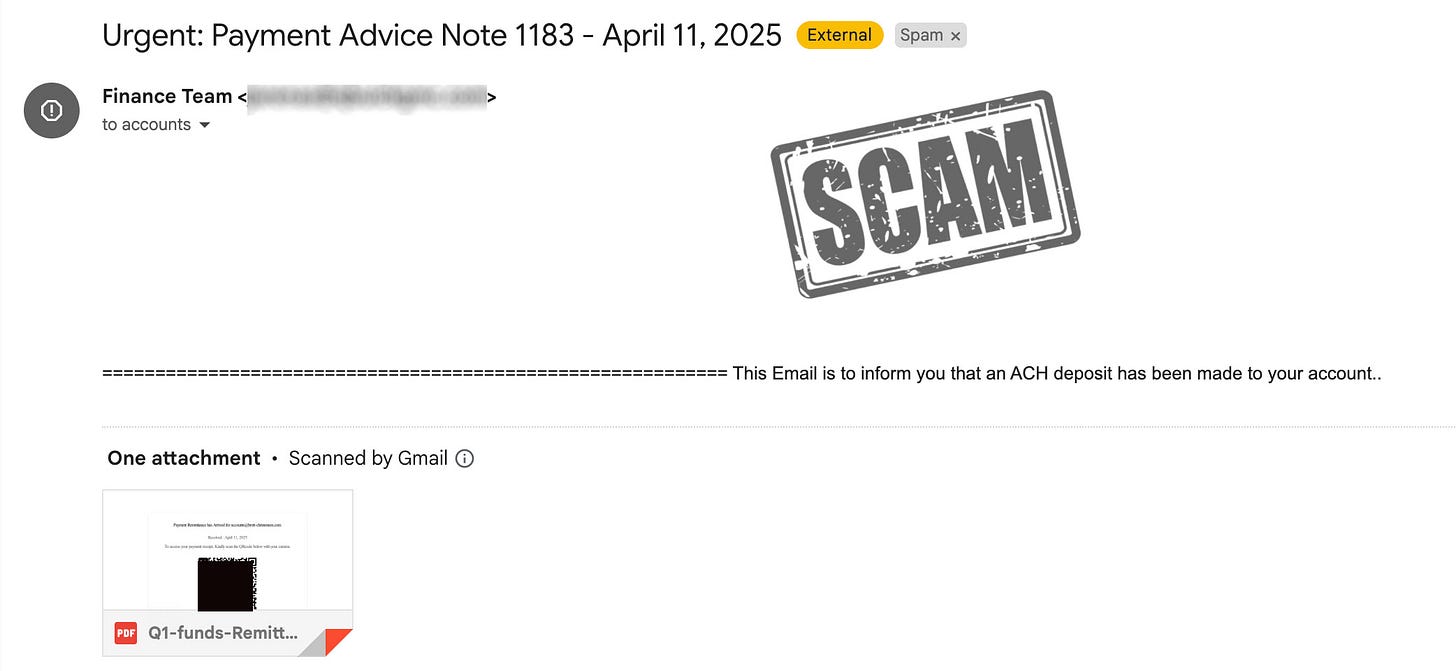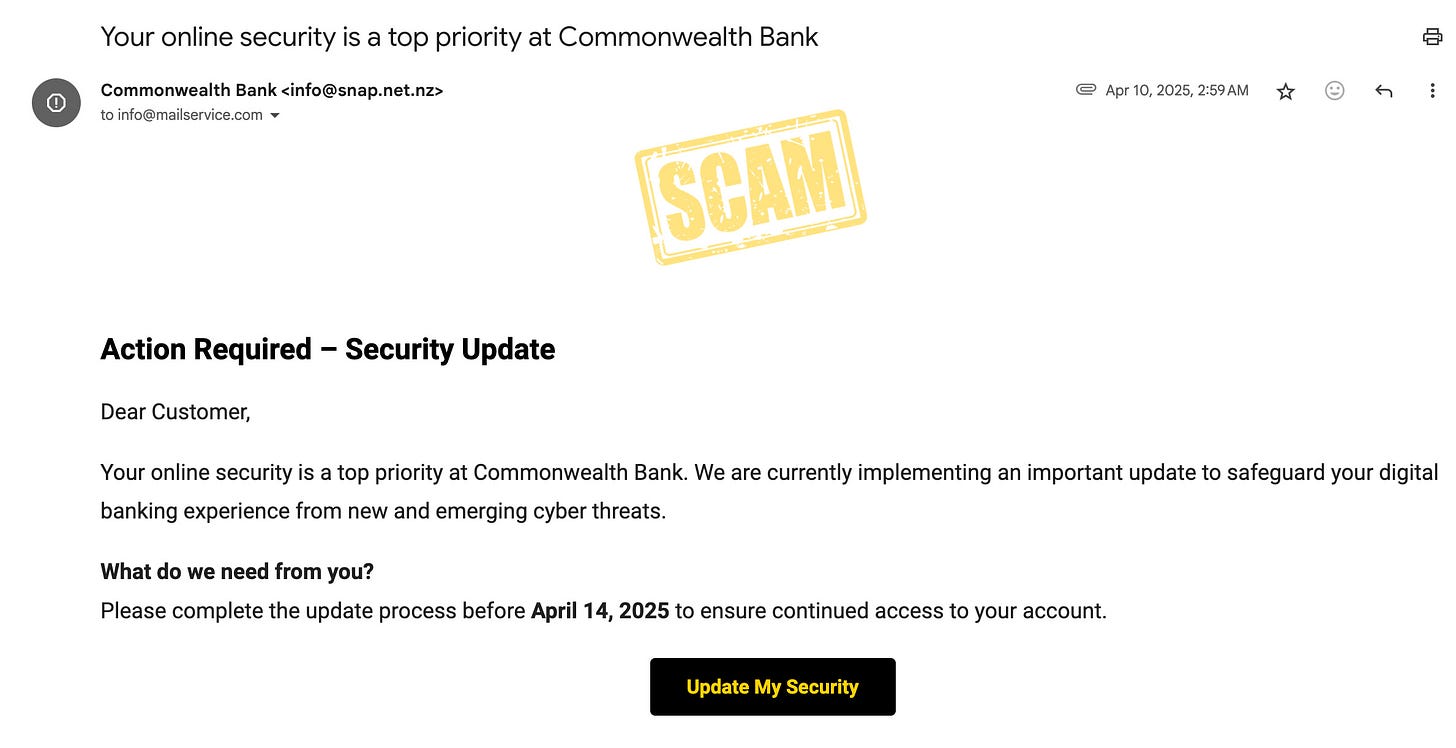Hoax-Slayer - Issue 8
QR code scams, Stanford University origin legend, why you should use a password manager, and security update scams.
Payment Advice QR Code Scams

Online criminals use many tactics to get people to visit their scam websites.
One such tactic involves attempting to trick people into scanning a QR code that opens a phishing website. The following example illustrates how these scams work.
An “urgent payment advice” email claims someone made an ACH deposit to your account. An ACH (Automated Clearing House) direct deposit is a common way for individuals to receive funds electronically for payroll, government benefits, tax refunds, and other payments.
Opening the attached file reveals a PDF with a QR code. The PDF urges you to scan the code to access your payment receipt.
However, scanning the code does not open a payment receipt. Instead, it loads a malicious website that asks you to provide credit card details and other personal information, ostensibly to prove your identity and access payment information.
Scammers will collect all of this information and use it to commit financial fraud and steal your identity.
Some versions may try to trick you into downloading malware or subscribing to dodgy services or software.
As with any other link, be wary when using QR codes. Check that the code is opening a legitimate website and not a fake copy.
It is always safest to access banking, government or other important websites by entering the address into your browser’s address bar or via an official app.
Screenshot of the scam email:
Screenshot of the attached file:
The Faded Gingham Dress – Stanford University Origin Legend

This enduring and entertaining tale supposedly outlines the origins of California’s prestigious Stanford University.
According to the story, after Mr and Mrs Leland Stanford were rudely rebuffed by the President of Harvard University when they offered to fund a building to honour the memory of their dead son, the pair subsequently established the university that bears their name. The story claims that the couple met such a cold and arrogant reception at Harvard because they were dressed in a “faded gingham dress” and a “homespun threadbare suit” and thereby had the appearance of penniless country bumpkins. It is a nice story and one that carries a valuable moral lesson – people should not make snap judgments based on a person’s initial appearance or demeanour.
However, while core elements in the tale are more or less factual, as a whole, it strays a long way from the truth. It is an urban legend that has been circulating for more than a decade. Leland and Jane Stanford did indeed establish Stanford University, they did visit Harvard University before establishing Stanford and, sadly, they did have a son that died young. Historical notes published on Stanford’s website suggest that the couple did indeed create the institution as a memorial to their son. However, any truth in the story well and truly ends with these few facts.
The family was well-to-do and certainly would not have dressed as poor country hicks, especially when attending an important meeting. Moreover, Leland Stanford was a powerful and influential man, astute at business, a political leader, later a U.S. Senator and at one point, Governor of California. Hardly the type of individual who would venture “timidly” into a university office and then quietly wait for hours to be seen. And the couple’s son, Leland Jr, died not of an accident, but of typhoid fever while travelling with his family in Italy. The boy was only 15 years old and was not attending Harvard or any other university at the time of his death. Before going ahead with plans to establish their university, the Stanfords did visit several eastern universities, including Harvard where they spoke to then-president Charles William Eliot. However, they were not rudely dismissed at these visits and in fact received valuable advice that helped them in their project. An entry in the Stanford University Libraries FAQ, dismissed the story as false, noting in part:
The thought of Leland and Jane Stanford, by this time quite wealthy, arriving at Harvard in a homespun threadbare suit and faded gingham dress is amusing, but highly inaccurate. It also is unlikely that Leland Stanford, a former governor of California and well-known railroad baron, and his wife Jane were knowingly kept waiting outside Eliot’s office. The Stanfords also visited Cornell, MIT, and Johns Hopkins.
The story was also resoundingly debunked in a 1998 edition of a university publication, the Stanford Magazine:
Take the tale of two “backwoods country hicks” that’s been zapped across the nation and around the world in countless e-mails over the last few months. The story has it that sometime in the 1880s a man and woman show up unannounced to meet with the president of Harvard. They talk to him about building a memorial for their son, who “accidentally killed” himself after his freshman year at Harvard. Eyeing the woman’s “faded gingham dress” and the man’s “homespun threadbare suit,” the president rudely informs them of the cost of building a university. “Is that all?” the woman says to her husband. “Why don’t we just start our own?” With that, the story goes, Leland and Jane Stanford returned to Palo Alto, “where they established the University that bears their name, a memorial to a son that Harvard no longer cared about.”
The account, of course, is wrong — and, in places, absurd. Leland Jr. died of typhoid fever at age 15. He never enrolled at Harvard. His parents did visit Harvard President Charles Eliot, but only to get advice on endowing a university. Perhaps most ridiculous is the notion that Sen. Stanford, a wealthy railroad baron, and his wife would show up in ratty clothes.
Still, the story lives on. Stanford officials have fielded questions from tourists, alumni, reporters — and Harvard itself. Archivist Margaret Kimball, ’80, was even asked to settle a bet between a husband and wife. “I might have caused a divorce,” she says.
Thus, while the story may be entertaining, it is not an accurate account of the founding of Stanford University. This version of the story falsely claims that it was penned by the late Malcolm Forbes, a well-known business leader and publisher of Forbes magazine.
The first quote included at the bottom of the message is generally attributed to American poet Maya Angelou. The slightly munged and abridged second quote, attributed in the message to James Arthur Ray, is more usually attributed to 19th Century American politician and orator, William Jennings Bryan who said, “Destiny is no matter of chance. It is a matter of choice. It is not a thing to be waited for, it is a thing to be achieved”.
Example
Subject: THE GINGHAM DRESS
A lady in a faded gingham dress and her husband, dressed in a Homespun threadbare suit, stepped off the train in Boston , and walked timidly without an appointment into the Harvard University President’s outer office.
The secretary could tell in a moment that such backwoods, country hicks had no business at Harvard and probably didn’t even deserve to be in Cambridge
‘We’d like to see the president,’ the man said softly. ‘He’ll be busy all day,’ the secretary snapped. ‘We’ll wait,’ the lady replied.
For hours the secretary ignored them, hoping that the couple would finally become discouraged and go away. They didn’t, and the secretary grew frustrated and finally decided to disturb the president, even though it was a chore she always regretted.
‘Maybe if you see them for a few minutes, they’ll leave,’ she said to him!
He sighed in exasperation and nodded. Someone of his importance obviously didn’t have the time to spend with them, and he detested gingham dresses and homespun suits cluttering up his outer office.
The president, stern faced and with dignity, strutted toward the couple. The lady told him, ‘We had a son who attended Harvard for one year. He loved Harvard. He was happy here. But about a year ago, he was accidentally killed. My husband and I would like to erect a memorial to him, somewhere on campus.’
The president wasn’t touched. He was shocked. ‘Madam,’ he said, gruffly, ‘we can’t put up a statue for every person who attended Harvard and died. If we did, this place would look like a cemetery.’
‘Oh, no,’ the lady explained quickly. ‘We don’t want to erect a statue. We thought we would like to give a building to Harvard.’
The president rolled his eyes. He glanced at the gingham dress and homespun suit, then exclaimed, ‘A building! Do you have any earthly idea how much a building costs? We have over seven and a half million dollars in the physical buildings here at Harvard.’
For a moment the lady was silent. The president was pleased. Maybe he could get rid of them now.
The lady turned to her husband and said quietly, ‘Is that all it costs to start a university? Why don’t we just start our own?’
Her husband nodded. The president’s face wilted in confusion and bewilderment. Mr. and Mrs. Leland Stanford got up and walked away, traveling to Palo Alto , California where they established the university that bears their name, Stanford University , a memorial to a son that Harvard no longer cared about.
You can easily judge the character of others by how they treat those who they think can do nothing for them.
…………………
A TRUE STORY By Malcolm Forbes‘People will forget what you said; People will forget what you did. But people will never forget how you made them feel’.
“Destiny is not a matter of chance, it is a matter of choice.”- James Arthur Ray
Important Security Tip: Use a Password Manager

If you are concerned about staying safe online, a dedicated password manager is pretty much a must-have.
Once your password manager is installed and configured, you only need to remember one master password from then on. This is much easier and considerably more secure than trying to remember multiple passwords or reusing the same passwords for multiple accounts.
Password manager programs can securely store all of your passwords and other private information. They also make it very simple to generate complex passwords that are likely to be much safer than ones you create yourself on the go.
Good password managers can scan your current passwords and email addresses and alert you if they have been compromised in past data breaches. They can also check your password health to identify weak passwords that may be vulnerable to attack and should be changed.
Modern browsers can store your login details for you. But your browser’s built-in password management system will not have the advanced functionality and security that you’ll get with a dedicated password manager.
Password Managers are relatively inexpensive and well worth the investment. Some excellent password managers are 1Password, Dashlane, and NordPass. You can usually get a free trial to test out the software and see if it’s a good fit.
Beware of Fake Security Update Notifications

Rather ironically, online crooks often use concern about increasing cyber threats to trick victims into compromising their personal information.
How? By sending out fake security update messages like the one shown below.
Typically, the messages claim you must click a link to implement an important security update that will help safeguard your account from scammers.
But the messages are themselves scams. Clicking the link won’t install a security update. Instead, it will open a phishing website that asks you to provide your account login credentials along with a large amount of other personal and financial information.
Scammers can harvest the information you provide and use it to hijack your account and steal your identity.
Security update scams like this target many banks and financial entities around the world and have been doing so for many years.
Be wary of any email or text message that claims that you must follow a link to implement a security update. Instead, log in to your account by entering the address in your web browser or via an official app. If changes or updates are really required, you will be notified after you log in to your account.
Screenshot of Fake Security Update Email:
Can You Help Support Hoax-Slayer?
If you find this publication useful, you can help in three ways:
#1: Spread the word: You can share this post or tell your friends about Hoax-Slayer:
#2: Buy Me A Coffee: Make a one-off (or regular) donation of an amount of your choosing:
#3: Become a paid subscriber: For just $6 (USD) per month, you can give vital ongoing support to Hoax-Slayer. What do you get for a paid subscription? I don’t believe in locking content about scams and security issues behind a paywall. So, the newsletter is the same for both free and paid subscribers. But you WILL get:
A warm fuzzy feeling from knowing that you are helping to thwart scammers and increase awareness by supporting the Hoax-Slayer project.
The chance to ask questions or make submissions via the exclusive subscriber-only chat.
Thanks! Any support that you offer will be greatly appreciated.





I always appreciate this information. Thanks, Brett!